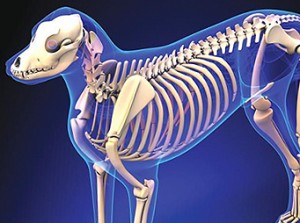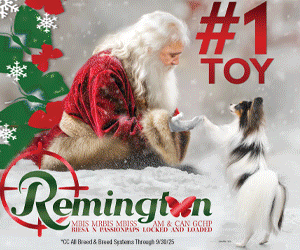The Mystery of Fronts – Anatomy by Reason
74 – August 2019
By Wayne Cavanaugh
 Take two fingers, starting at the top of your shoulder, and trace the bone that runs horizontally from the top of your shoulder blade (scapula) to the bone (sternum) that sits vertically in the center of your rib cage. That horizontal connecting bone is your clavicle, less for- merly known as the collar bone. They are easy to find and see because, unlike most bones, clavicles are not covered in muscle; they are only covered by skin. They are also the only horizontal bones in our body. Most important, however, clavicles connect our arms to our torso. Why is it important to know that humans have a collar bone that actually connects our shoulders to our torso? Because dogs do not.
Take two fingers, starting at the top of your shoulder, and trace the bone that runs horizontally from the top of your shoulder blade (scapula) to the bone (sternum) that sits vertically in the center of your rib cage. That horizontal connecting bone is your clavicle, less for- merly known as the collar bone. They are easy to find and see because, unlike most bones, clavicles are not covered in muscle; they are only covered by skin. They are also the only horizontal bones in our body. Most important, however, clavicles connect our arms to our torso. Why is it important to know that humans have a collar bone that actually connects our shoulders to our torso? Because dogs do not.
Orangutans have tremendous strength and flexibility in their shoulders. They can extend their arms, grab a tree limb with one hand, support their hundreds of pounds of wonderfulness with the other, and hoist themselves up to a higher limb. They, of course, have some pretty impressive collar bones holding it all together. Dogs do not.
In fact, dogs don’t have any bones to connect their shoulder blades to their body. Instead, they are attached with just muscles and ligaments. Think about that for a minute. The dogs entire front is attached to its torso, but not by bones. How important, then, is the placement, angle and balance of the front assembly to make this particular attachment as efficient as possible?
The reason that dogs don’t have actual collar bones is purely functional. Dogs, like their ancestral wolves, are a “predatory cursorial” species; that is, they are designed to run. Cursorial mammals are runners that can cover large areas, find distant sources of food and water, chase down prey, or escape from predators and enemies. Unlike non-cursorial mammals – for example, humans – they don’t need to lift, push or pull objects to get food and they don’t need to rotate their arms every which way. Those kinds of functions require an entirely different system for attaching front assemblies to torsos….including, you guessed it, collar bones.
As predatory cursorial animals, dogs need to excel in two things: speed and agility. Along with a spine that can amazingly bend and stretch, and a powerful hindquarter to provide forward propulsion, dog’s shoulders are designed for balance and to increase the length of their stride. To make this all happen, extreme flexibility is vital and fundamental.
Click here to read the complete article74 – August 2019
Short URL: https://caninechronicle.com/?p=168043
Comments are closed











